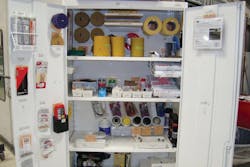The industry today is acutely focused on lean processes and removal of waste. Customers and insurers want lower repair bills, and the only way to do that without hindering profitability is to get faster while reducing expenses, says Aaron Marshall, owner of Marshall Auto Body in Waukesha, Wis. Better materials management is one component of doing that.
Marshall discusses how implementation of a linear repair process leads to a better method for managing shop materials.
In traditional repair systems, each technician operates individually. They perform disassembly, body repair and assembly processes, and need supplies to do all of those tasks. That requires a lot of materials, enough for when everybody needs things at the same time. But during the rest of the week, when technicians don’t all need the same materials, you develop an excess of supplies, some of which dry up and get thrown out. Shops need to consider working in less of a disconnected manner to fix those problems. They need a logical, connected process that requires a minimum amount of inventory.
You can achieve this with a linear repair process, which is what we use. Meaning, specific functions of the repair process are performed by one technician in a dedicated area of the facility. We only disassemble in one designated stall. We do body work in one area. We assemble in one area. We stock each repair area only with what those areas require to work. For example, the reassembly area has nothing but glue and urethane for window installation. There are no other materials needed to reassemble cars.
Our materials inventory system is very simple. It’s about what materials are needed, where they belong, and how much should be available at one time. Here’s how we manage it:
1. We keep 2.5 days worth of materials on hand, which is replenished exactly at 2.5-day intervals. Because we work in a connected process, we’re able to mathematically determine how much we need of everything. We have very little on hand, so there’s very little that can get misplaced and little amounts of cash tied up in inventory.
2. Every product and piece of hardware has a “reorder” card placed behind it in the storage cabinet. When the technician takes a product and the “reorder” card becomes exposed, it’s a visual signal to drop the card into a bin labeled “restock needed.” Those “restock needed” bins exist in four areas of the shop.
We do have a backstock called “buffer inventory.” We keep on hand what we’re using, plus one extra. For example, we have five grinding discs. We put the “reorder” card behind four of them so there is still one left while we’re waiting for the delivery of five more. That way we never run out.
3. Twice a week, every 2.5 days, an employee walks around with order sheets color-coded by vendor that match the “reorder” cards. The employee finds the item in the “restock needed” bin and marks down how many we need on the order sheet. Then the “reorder” cards are moved to another bin labeled “awaiting delivery.”
4. The employee faxes or emails the orders. We don’t allow use of the phone in the ordering process. That’s because the inventory sheets are used to track our ordering habits, such as frequency of rush deliveries or certain products. Tracking that data helps identify problems that arise or repair trends so we can constantly improve.
5. The supplier delivers all of the ordered items. We don’t allow them to give us any packaging or cardboard boxes. We have plastic tubs that get sent back and forth. Whenever suppliers drop something off, they put it into a tub and pick up another empty tub when they leave.
6. The tubs are put on carts, and wheeled to each material storage area in the building. The “reorder” card is taken out of the “awaiting delivery” bin, attached back in place in the storage cabinet, and the new set of products are loaded in front of it. The stock process is ready to start over again.
This process for materials management is not a little pet project that we think works well. It’s essential in order for our connected repair system to run efficiently and effectively. It’s necessary to maintain low inventory while constantly having what we need, when we need it and where we need it without ever having too much or too little. We are able to extract very high profit on all materials because we waste so little.



